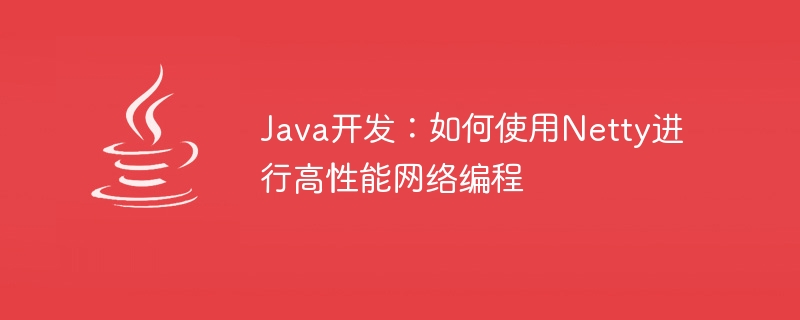Home >Java >javaTutorial >Java development: How to use Netty for high-performance network programming
Java development: How to use Netty for high-performance network programming
- PHPzOriginal
- 2023-09-20 14:09:231196browse

Java development: How to use Netty for high-performance network programming
Abstract: Netty is a high-performance, asynchronous event-driven network programming framework that can simplify network applications development process. This article will introduce the main features of Netty and how to use Netty for high-performance network programming. At the same time, we will also provide some specific Java code examples to help readers better understand and apply Netty.
1. Introduction to Netty
Netty is a network programming framework based on Java NIO, which can quickly and easily develop maintainable high-performance server and client applications. It provides a set of highly abstract APIs, allowing developers to focus on the implementation of business logic without paying too much attention to the underlying details of network IO.
The main features of Netty include:
- Asynchronous non-blocking: Netty uses the non-blocking IO model provided by Java NIO to achieve high concurrency processing and resource saving.
- Event-driven: Netty is based on the event-driven model and achieves efficient network operations through the event distribution mechanism.
- Highly customizable: Netty provides a series of customizable options and processors, allowing developers to adjust and extend the functionality of the framework according to their own needs.
- Strong fault tolerance: Netty’s fault tolerance mechanism can handle various abnormal situations to ensure the stability and reliability of the application.
- Rich functions: Netty provides a series of advanced functions, such as SSL/TLS support, HTTP protocol codecs, WebSocket, etc., allowing developers to easily build complex network applications.
2. Netty high-performance network programming practice
Below we will use a simple example to introduce how to use Netty for high-performance network programming.
- Introducing Netty dependencies
First, we need to introduce Netty related dependencies in the dependency management of the project. For example, in a Maven project, you can add the following configuration to the pom.xml file:
<dependencies>
<dependency>
<groupId>io.netty</groupId>
<artifactId>netty-all</artifactId>
<version>4.1.59.Final</version>
</dependency>
</dependencies>- Writing server-side code
Next, we create a simple server-side application, Used to receive connections and messages from clients. The following is a sample code:
public class Server {
public static void main(String[] args) throws Exception {
EventLoopGroup bossGroup = new NioEventLoopGroup();
EventLoopGroup workerGroup = new NioEventLoopGroup();
try {
ServerBootstrap bootstrap = new ServerBootstrap();
bootstrap.group(bossGroup, workerGroup)
.channel(NioServerSocketChannel.class)
.childHandler(new ChannelInitializer<SocketChannel>() {
@Override
public void initChannel(SocketChannel ch) {
ChannelPipeline pipeline = ch.pipeline();
pipeline.addLast(new StringEncoder());
pipeline.addLast(new StringDecoder());
pipeline.addLast(new ServerHandler());
}
});
ChannelFuture future = bootstrap.bind(8888).sync();
future.channel().closeFuture().sync();
} finally {
workerGroup.shutdownGracefully();
bossGroup.shutdownGracefully();
}
}
}In this code, we create two EventLoopGroups, one for handling client connections and one for handling client requests. Then we created a ServerBootstrap, set relevant parameters, and bound the processor (ServerHandler).
- Writing client code
Next, we create a simple client application for sending messages to the server and receiving responses from the server. The following is a sample code:
public class Client {
public static void main(String[] args) throws Exception {
EventLoopGroup group = new NioEventLoopGroup();
try {
Bootstrap bootstrap = new Bootstrap();
bootstrap.group(group)
.channel(NioSocketChannel.class)
.handler(new ChannelInitializer<SocketChannel>() {
@Override
public void initChannel(SocketChannel ch) {
ChannelPipeline pipeline = ch.pipeline();
pipeline.addLast(new StringEncoder());
pipeline.addLast(new StringDecoder());
pipeline.addLast(new ClientHandler());
}
});
ChannelFuture future = bootstrap.connect("localhost", 8888).sync();
future.channel().closeFuture().sync();
} finally {
group.shutdownGracefully();
}
}
}In this code, we create an EventLoopGroup, then create a Bootstrap, set relevant parameters and bind the processor (ClientHandler).
- Writing processor code
Finally, we need to write specific processor code to handle the sending and receiving of messages between the server and the client. The following is a sample code:
public class ServerHandler extends ChannelInboundHandlerAdapter {
@Override
public void channelRead(ChannelHandlerContext ctx, Object msg) {
System.out.println("Received message from client: " + msg);
ctx.write("Server response: " + msg);
}
@Override
public void channelReadComplete(ChannelHandlerContext ctx) {
ctx.flush();
}
@Override
public void exceptionCaught(ChannelHandlerContext ctx, Throwable cause) {
cause.printStackTrace();
ctx.close();
}
}
public class ClientHandler extends ChannelInboundHandlerAdapter {
@Override
public void channelActive(ChannelHandlerContext ctx) {
ctx.writeAndFlush("Hello from client!");
}
@Override
public void channelRead(ChannelHandlerContext ctx, Object msg) {
System.out.println("Received response from server: " + msg);
}
@Override
public void channelReadComplete(ChannelHandlerContext ctx) {
ctx.flush();
}
@Override
public void exceptionCaught(ChannelHandlerContext ctx, Throwable cause) {
cause.printStackTrace();
ctx.close();
}
}In this code, we define ServerHandler and ClientHandler respectively, and rewrite the corresponding methods to implement message processing.
3. Summary
This article introduces the main features of Netty, and uses a simple sample code to show how to use Netty for high-performance network programming. By using Netty, we can simplify the development process of network applications and achieve high concurrency processing and resource saving. I hope this article will help you understand and apply Netty.
Reference materials:
- Netty official documentation: https://netty.io/wiki/index.html
- Netty GitHub repository: https://github .com/netty/netty
The above is the detailed content of Java development: How to use Netty for high-performance network programming. For more information, please follow other related articles on the PHP Chinese website!

